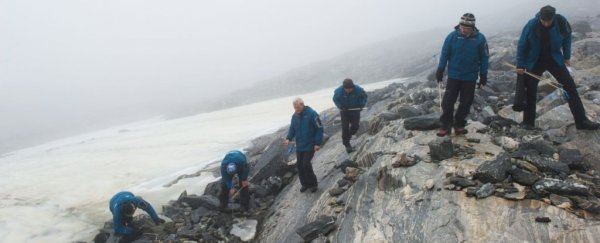One of the consequences of a warming planet is receding glaciers, and archaeologists working on ice sheets on highest peaks of Norway have discovered a treasure trove of artefacts dating back as far as 4000 BCE.
They include clothes, weaponry, and even ancient skis, and more than 2,000 relics have been recovered from the Jotunheimen area and the surrounding mountains in Oppland. Perfectly preserved packhorse skeletons have also been found.
As part of the work, the international team of researchers are carbon dating the artefacts to establish patterns of hunting and trade in the ancient communities who once roamed these icy mountains, revealing some interesting trends of the Bronze and Iron Ages.
 One of the finds. (Secrets of the Ice)
One of the finds. (Secrets of the Ice)
"One such pattern which really surprised us was the possible increase in activity in the period known as the Late Antique Little Ice Age," says one of the team, James H. Barrett from the University of Cambridge in the UK.
This was a period of cooler temperatures covering 536-660 CE, when harvests would probably have been failing, and populations might have shrunk. However, there was no corresponding drop in the number of items recovered from this period, suggesting that it was business as usual as far as mountain hunting and trading went.
"We then see particularly high numbers of finds dating to the 8th-10th centuries CE, probably reflecting increased population, mobility – including the use of mountain passes – and trade," says Barrett.
This period just before and during the Viking Age was a time of general outward expansion in Scandinavia. More towns means more people needing antlers and furs – with reindeer being the animals most often hunted, venturing higher to escape biting insects below – and the hunters themselves may have been getting more ambitious too.
 A walking stick with a runic inscription from the 11th century. (Vegard Vike, Museum of Cultural History.)
A walking stick with a runic inscription from the 11th century. (Vegard Vike, Museum of Cultural History.)
For other times, such as from the 11th century onwards, there's a drop in the number of discovered items, the archaeologists report. Downturns like this could be explained by improved farming methods, worsening climatic conditions, or (in the case of a mid-14th century slump in activity) the arrival of the plague.
The thawed out relics can therefore give us a fascinating glimpse into the past, with the ice freezing artefacts that would otherwise have been lost a long time ago.
And these glacial archaeologists are tasked with trying to preserve these historical finds as they emerge from the ice and before they're destroyed by whatever weather conditions come next – clothing and textiles are particularly susceptible to decay.
As a result the fieldwork needs to be "well-timed and systematic", Barrett told Ars Technica, to catch these finds as the ice melts. The work continues, so we're likely to be learning a lot more about Norwegian history in the future.
"Fieldwork is hard work – hiking with all our equipment, often camping on permafrost – but very rewarding," Barrett told Ars Technica.
"[You're] rescuing the archaeology, bringing the melting ice to wider attention, discovering a unique environmental history and really connecting with the natural environment."
You can see more of the work in this 2016 video and by visiting the archaeologists' own website, where they are recording their finds.
The research has been published in Royal Society Open Science.
